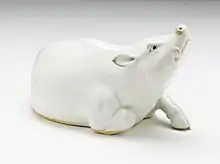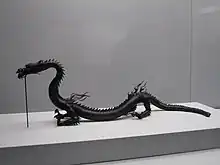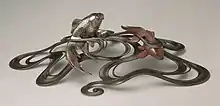Okimono
Okimono (置物)[1] is a Japanese term meaning "ornament for display; objet d'art; decorative object", typically displayed in a tokonoma alcove or butsudan altar.


Etymology
The Japanese word okimono compounds oku (置く, "put; place; set; lay out; assign; station; leave") and mono (物, "thing; object; article").. The Oxford English Dictionary defines the loanword okimono as "A standing ornament or figure, esp. one put in a guest room of a house", and records the first usage in 1886 by William Anderson.[2]

Description
An okimono may be a small Japanese carving, similar to, but larger than netsuke. Unlike netsuke, which have a specific purpose, okimono are purely decorative and are displayed in the tokonoma. An okimono can be made out of wood, ivory, ceramic or metal.
One subcategory of okimono is the jizai okimono, an articulated figure often made out of bronze or iron.
Okimono are normally not larger than a few centimetres. They depict all sorts of animals, mythological beasts, humans, gods, fruit, vegetables and objects, sometimes combined with each other, in all sorts of positions. Sometimes a scene is portrayed as well, either a daily scene or from a story.
Anything that could be carved or made into a small object can be used in an okimono. Some okimono were inspired by a group of objects and were supposed to be shown together as an ensemble.
History
During the Meiji period, many okimono were made for export to the West. One of the most renowned artists in the area of metalwork was Yamada Sōbi (1871-1916), who made pieces out of a single sheet of metal.
References
- Kenkyusha's New Japanese-English Dictionary, Kenkyusha Limited, ISBN 4-7674-2015-6
- Oxford English Dictionary (2009), CD-ROM edition (v. 4.0).
External links
![]() Media related to Okimono at Wikimedia Commons
Media related to Okimono at Wikimedia Commons
- Netsuke: masterpieces from the Metropolitan Museum of Art, an exhibition catalog from The Metropolitan Museum of Art (fully available online as PDF), which contains many example okimono
- English online dictionary definition, related information, and various visual examples